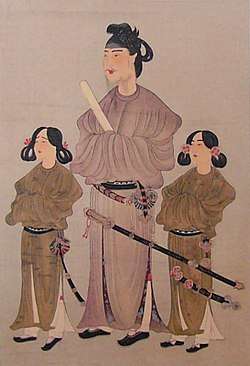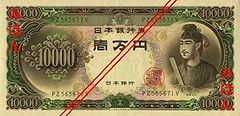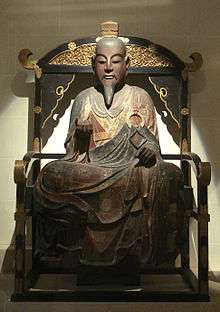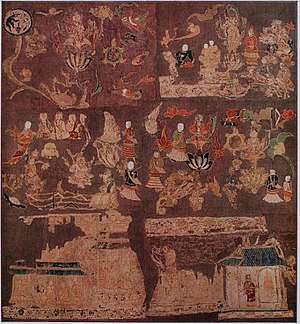Prince Shōtoku
Prince Shōtoku (聖徳太子, Shōtoku Taishi, February 7, 574 – April 8, 622[2]), also known as Prince Umayado (厩戸皇子, Umayado no ōjî) or Prince Kamitsumiya (上宮皇子, Kamitsumiya no ōji), was a semi-legendary regent and a politician of the Asuka period in Japan who served under Empress Suiko. He was the son of Emperor Yōmei and his consort, Princess Anahobe no Hashihito, who was also Yōmei's younger half-sister. His parents were relatives of the ruling Soga clan[3] and also he was involved in the defeat of the rival Mononobe clan.[4] The primary source of the life and accomplishments of Prince Shōtoku comes from the Nihon Shoki.
| Prince Shōtoku | |
|---|---|
 Prince Shōtoku flanked by younger brother (left: Prince Eguri) and first son (right: Prince Yamashiro), drawn by unknown author.[1] | |
| Born | February 7, 574 |
| Died | April 8, 622 (aged 48) |
| Spouse | Uji no Shitsukahi Tojiko no Iratsume |
| Issue | Prince Yamashiro |
| House | Yamato |
| Father | Emperor Yōmei |
| Mother | Princess Anahobe no Hashihito |
Over successive generations, a devotional cult arose around the figure of Prince Shōtoku for the protection of Japan, the Imperial Family, and for Buddhism. Key religious figures such as Saichō, Shinran and others claimed inspiration or visions attributed to Prince Shōtoku.[4]
Cultural and political role

According to tradition, Shōtoku was appointed regent (Sesshō) in 593 by Empress Suiko (554–628), his aunt.[5] Shōtoku, inspired by the Buddha's teachings, succeeded in establishing a centralized government during his reign. In 603, he established the Twelve Level Cap and Rank System at the court. He is credited with promulgating a Seventeen-article constitution.
The Prince was an ardent Buddhist and is traditionally attributed the authorship of the Sangyō Gisho or "Annotated Commentaries on the Three Sutras" (the Lotus Sutra, the Vimalakirti Sutra, and the Śrīmālādevī Siṃhanāda Sūtra). The first of these commentaries, Hokke Gisho, is traditionally dated to 615 and thus regarded as "the first Japanese text", in turn making Shōtoku the first Japanese writer.
A legend claims that when Bodhidharma came to Japan, he met with Prince Shōtoku whilst under the guise of a starving beggar. The Prince asked the beggar to identify himself, but the man did not reply. Instead of going ahead, Shōtoku gave him food, drink, and covered him with his purple garment, telling him to "lie in peace". The Prince then sang for the starving man.
Alas! For The wayfarer lying And hungered for rice On the hill of Kataoka (The sunshiny) Art thou become Parentless? Hast thou no lord Flourishing as a bamboo? Alas! For The wayfarer lying And hungered for rice!
The second day, the Prince sent a messenger to the starving man, but he was already dead. Hereupon, Shōtoku was greatly grieved and ordered his burial. Shōtoku later thought the man was no ordinary man for sure, and sending another messenger, discovered the earth had not been disturbed. On opening the tomb there was no body inside, and the Prince's purple garment lay folded on the coffin. The Prince then sent another messenger to claim the garment, and he continued to wear it just as before. Struck by awe, the people praised the Prince: "How true it is that a sage knoweth a sage." This legend is linked with the temple of Daruma-dera in Ōji, Nara, where a stone stupa was found underground, which is exceedingly rare.
Prince Shōtoku commissioned the Shitennō-ji (temple) in Settsu Province (present-day Osaka) after his military victory against the powerful Mononobe clan, for he is said to have summoned them to crush his enemies. Shōtoku's name has been linked with Hōryū-ji, a temple in Yamato Province, and numerous other temples in the Kansai region. Documentation at Hōryū-ji claims that Suiko and Shōtoku founded the temple in the year 607. Archaeological excavations in 1939 have confirmed that Prince Shōtoku's palace, the Ikaruga no miya (斑鳩宮), stood in the eastern part of the current temple complex, where the Tō-in (東院) sits today.[6]
Despite being credited as the founder of Japanese Buddhism, it is also said that the Prince respected Shinto and never visited Buddhist temples without visiting Shinto shrines.[7]
In his correspondence with Emperor Yang of Sui, the Prince's letter contains the earliest known written instance in which the Japanese archipelago is referred to by a term meaning "land of the rising sun." The Sui Emperor had dispatched a message in 605 that said, "the sovereign of Sui respectfully inquires about the sovereign of Wa," and Shōtoku responded by sponsoring a mission led by Ono no Imoko in 607, who brought along a note reading: "From the sovereign of the land of the rising sun (hi izuru tokoro) to the sovereign of the land of the setting sun."[8][9][10]
He is said to have been buried at Shinaga in Kawachi Province (modern Osaka Prefecture).[11]
Titles and name
Shōtoku is known by several titles, although his real name is Prince Umayado (厩戸皇子, Umayado no ōji, literally ‘the prince of the stable door’) since he was born in front of a stable.[12] He is also known as Toyotomimi (豊聡耳) or Kamitsumiyaō (上宮王). In the Kojiki, his name appears as Kamitsumiya no Umayado no Toyotomimi no Mikoto (上宮之厩戸豊聡耳命). In the Nihon Shoki, in addition to Umayado no ōji, he is referred to as Toyomimito Shōtoku (豊耳聡聖徳), Toyotomimi no Nori no Ōkami (豊聡耳法大王), and simply Nori no Ushi no Ōkami (法主王).
The name by which he is best known today, Prince Shōtoku, first appeared in Kaifūsō, written more than 100 years after his death in 622 AD.
Legacy
A number of institutes are named after him, such as Shotoku Gakuen University and its associated junior college (both in Gifu). The first syllable of his name (聖), can be read shō in Go-on and can also be read sei in Kan-on. The later reading is found in Seitoku University and its associated junior college (both in Matsudo, Chiba) as well as Tokyo's defunct Seitoku Junior College of Nutrition (and indirectly its replacement Seiei College).
In currency

The portrait of Prince Shōtoku has appeared before on 100, 1,000, 5,000 and 10,000 yen bills.[13] Two bills made with different types of materials and special inks with a face value of 100,000,000 (One hundred million yen) were also issued. The characteristic of these bills is that they have a border around it to prevent its alteration. As characteristics, it has a seal and figures in different positions starting from the middle outwards. The measurements of these 2 issues of bills are 35.3 cm x 16 cm and the other with a small variation of 34.3 by 16.5 cm. These cloth tickets were used for the exchange of important values at that time.
Gallery
 Wood statue of Prince Shōtoku
Wood statue of Prince Shōtoku
 Statue of Shōtoku as a child, c. 1200-1350 AD
Statue of Shōtoku as a child, c. 1200-1350 AD The Tenjukoku Shūchō Mandala, created to commemorate Shōtoku's death (622 AD)
The Tenjukoku Shūchō Mandala, created to commemorate Shōtoku's death (622 AD)
See also
Notes
- Binyon, Laurence (2006). Painting in the Far East: An Introduction to the History of Pictorial Art in Asia, Especially China and Japan. Elibron.com. p. 85. ISBN 0-543-94830-7.
The author of this portrait is unknown; it is generally held to be the work of Korean artist, but is quite probably the work of native hand.
- A History of Japan, R.H.P. Mason and J.G. Caiger, Charles E.Tuttle Company, Inc., Tokyo 1977, 0221-000349-4615
- "Archived copy". Archived from the original on 2010-09-16. Retrieved 2010-03-01.CS1 maint: archived copy as title (link)
- Como, Michael I. (2006). Shōtoku: ethnicity, ritual, and violence in the Japanese Buddhist tradition. New York: Oxford University Press. ISBN 0-19-518861-6.
- Buswell, Robert Jr; Lopez, Donald S. Jr., eds. (2013). Princeton Dictionary of Buddhism. Princeton, NJ: Princeton University Press. pp. 811–812. ISBN 9780691157863.CS1 maint: ref=harv (link)
- John Whitney Hall (1988). "The Asuka Enlightenment". The Cambridge History of Japan. Cambridge University. p. 175. Retrieved 2007-04-03.
- Shōichi Watanabe (Professor Emeritus at Sophia University) (2014), 教育提言:私が伝えたい天皇・皇室のこと[My opinion concerning education: What I must hand down regarding the Emperor and the Imperial Family of Japan]. In Seiron, 508, 204-211.
- Varley, Paul. (1980). Jinnō Shōtōki, p. 128.
- Varley, Paul. (1973). Japanese Culture: A Short History. p. 15
- "遣隋使". Chinese Encyclopedia Online. Original text: 日出處天子致書日沒處天子無恙 (Book of Sui, Volume 81)
- Guth, Christine. "The Divine Boy in Japanese Art." Monumenta Nipponica 42:1 (1987). p12.
- "Answers - The Most Trusted Place for Answering Life's Questions".
- "Security Features of Bank of Japan Notes". Bank of Japan.
References
- Como, Michael A. (2008). Shotoku: Ethnicity, Ritual and Violence in the Japanese Buddhist Tradition. New York: Oxford University Press. ISBN 978-0-19-518861-5
- Varley, H. Paul. (1973). Japanese Culture: A Short History. New York: Praeger Publishers.
- Varley, Paul. (1980). Jinnō Shōtōki: A Chronicle of Gods and Sovereigns. New York: Columbia University Press. ISBN 978-0-231-04940-5; OCLC 59145842
Bibliography
- Pradel, Chari (2008). Shoko Mandara and the Cult of Prince Shotoku in the Kamakura Period, Artibus Asiae 68 (2), 215-246
External links
![]()
| Wikiquote has quotations related to: Prince Shōtoku |